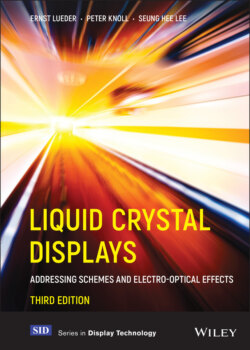Читать книгу Liquid Crystal Displays - Ernst Lueder - Страница 37
4.2.3 The mixed mode twisted nematic cell (MTN cell)
ОглавлениеIn this mode the polarizer is at an angle α ≠ 0 to the x-axis while the director exhibits a twist β, in most cases β = π/2. The twist starts with the LC molecules anchored parallel to the x-axis. This situation gives rise to two modes of propagation of light from which the term mixed mode is derived.
The first mode is based on linearly polarized light feeding in both a wave with a field component parallel to the x-axis experiencing n|| and a wave with a y-component experiencing n┴. As n|| > n┴, the speed of propagation of the x-component is smaller than the speed of the y-component; the x-axis is the slow axis and the y-axis is the fast one. The effect at the output is based on this birefringence. Examples for this mode are all the untwisted nematic cells that were described in Chapter 3.
Figure 4.9 Transmitted spectrum of a 240° STN display with the addressing voltage as a parameter (Reproduced from Scheffer and Nehring, 1998 with permission of Annual Reviews.)
The second mode stems from the twist of the molecules given in Equation (4.51) for α = 0, yielding
(4.77)
with
(4.78)
derived from Equation (4.64).
For β << πdΔn/λ Equation (4.77) can be approximated by
(4.79)
where β0 from Equation (4.50) was used. This result indicates that the component in the σ-axis represents the entire propagating wave. This axis rotates with the twist of the LC molecules we introduced during the derivation of the general result in Equation (4.51). Hence, the wave is guided by the twist. This waveguiding effect, also called the adiabatic following, is the second mode of propagation.
The derivation of the transmission in the MTN mode starts with the general Equations (4.66) and (4.67) for the Jones vectors in the x′ –y′ coordinates in Figure 4.1. We know from Equation (4.72) that maximum transmission takes place for ψ = −α, and the analyser in the ψ-direction. We now pursue this case, and obtain from Equations (4.66) and (4.67) ψ = −α for
(4.80)
(4.81)
The polarizers are crossed with a 90 angle for α = π/4, which as is shown in our discussion of Equation (4.76), yields a normally white state with an excellent black state. For α = π/4, Equations (4.80) and (4.81) yield
(4.82)
and
(4.83)
The intensity Isx′ of the light passing through the polarizer in the x′ direction in the normally white state with α = −ψ = π/4 is
(4.84)
with
Isx′ is plotted in Figure 4.10 versus a for β = π/2; zeros are at a = 0, whereas maxima occur at The maximum at leads to . The fully on state offers an excellent black independent of λ. The normally black state with parallel polarizers possesses a black state for Osy′ = 0, that is, for γ(λ) = π. More on MTNs is presented in the following two chapters.
